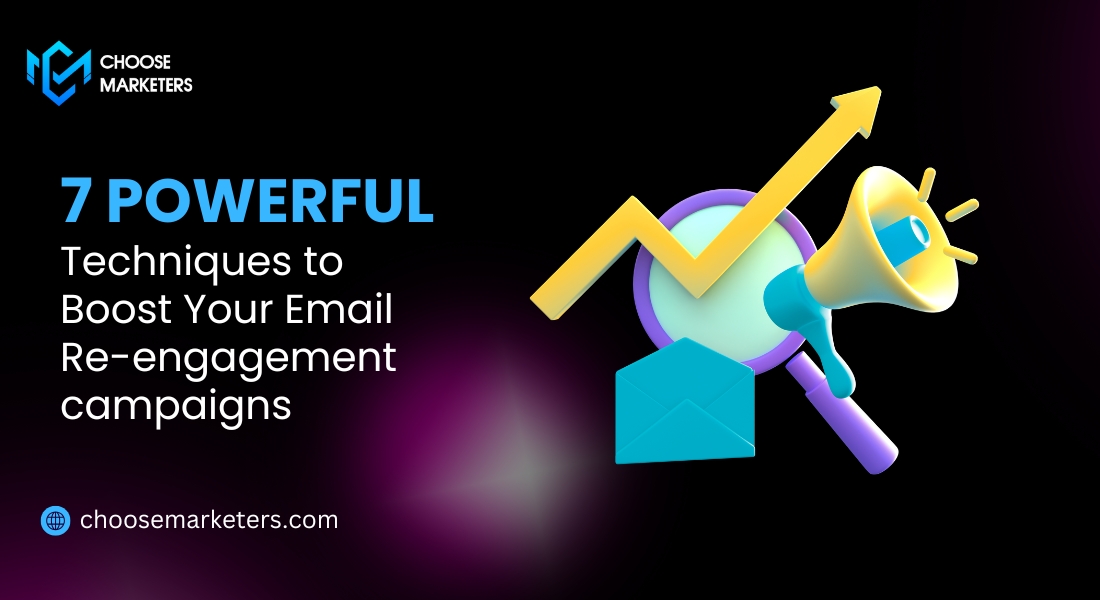

7 Powerful Techniques to Boost Your Email Re-engagement campaigns
In today’s digital space, businesses face the challenge of email re-engagement campaigns. With email inboxes overflowing and attention spans dwindling, it’s no surprise that even the most loyal subscribers can go silent. Did you know that, on average, 25-50% of email lists are considered inactive? This startling statistic highlights the critical need for businesses to implement effective email re-engagement campaigns to reconnect with their dormant subscribers.
Why does this matter? Ignoring inactive subscribers can severely impact your email marketing performance, from reduced open rates to increased chances of emails being marked as spam. On the flip side, a well-executed re-engagement campaign can revitalize your audience, boost conversions, and ultimately drive more revenue. This blog will explore the essential strategies to craft successful email re-engagement campaigns tailored specifically for the U.S. market, providing you with actionable insights to reawaken your inactive subscribers.
By the end of this blog, you’ll have a clear roadmap to not only win back your inactive subscribers but also to enhance the overall effectiveness of your email marketing efforts.
But before we dive into the details, let’s set the stage with a quick overview of the importance of email re-engagement campaigns.
Stay with us as we delve into these critical strategies that could transform your email marketing and bring your dormant subscribers back to life.
1. Identifying and Segmenting Inactive Subscribers
The first step in any successful email re-engagement campaign is identifying which subscribers have become inactive. Typically, an inactive subscriber is someone who hasn’t opened or clicked on your emails in a certain period, often six months or more. However, this timeframe can vary depending on your industry and audience behavior.
Once you’ve identified these inactive subscribers, the next step is segmentation. Segmentation is crucial because it allows you to tailor your re-engagement efforts to different groups within your inactive audience. For example, you might segment based on the length of inactivity, the types of products they previously showed interest in, or their past engagement levels. By creating targeted segments, you can deliver more personalized and relevant content, increasing the chances of re-engagement.
2. Crafting Effective Re-engagement Email Content
Content is king, and this is especially true when it comes to email re-engagement campaigns. The content of your re-engagement emails should be carefully crafted to capture the attention of your inactive subscribers. This involves more than just offering a discount or special promotion; it requires a thoughtful approach that speaks directly to the reasons why these subscribers became inactive in the first place.
Consider incorporating personalization into your email content. Personalized emails are proven to perform better than generic ones, as they make the recipient feel valued. Use the subscriber’s name, reference their past behavior or purchases, and suggest products or content that align with their interests. Additionally, the tone of your email should be friendly and encouraging, inviting the subscriber to rediscover the value of your brand.
3. Personalization Strategies for Enhanced Engagement
Personalization is one of the most powerful tools in an email marketer’s arsenal, and it plays a crucial role in email re-engagement campaigns. In the context of re-engagement, personalization goes beyond simply using the subscriber’s name; it involves creating a highly tailored experience based on their past interactions with your brand.
One effective strategy is to personalize the subject line and preview text of your emails. These are the first things a subscriber sees, and if they resonate on a personal level, they are more likely to open the email. Inside the email, you can use dynamic content blocks to show different images, offers, or messages based on the subscriber’s previous behaviors or preferences.
For example, if a subscriber has shown interest in a particular product category, you can highlight similar products in your re-engagement email. You can also offer personalized discounts or incentives based on their past purchases. By making the content of your emails feel more relevant and customized, you increase the likelihood of re-engagement.
4. Designing Impactful Email Templates
The design of your re-engagement emails is just as important as the content. A well-designed email template can make your message more appealing and easier to digest. When designing templates for email re-engagement campaigns, consider the following elements:
Visual Appeal: Use high-quality images, consistent branding, and a clean layout to make your emails visually appealing. Ensure that the design aligns with your brand’s identity and resonates with your target audience in the U.S. market.
Mobile Optimization: A significant portion of emails are opened on mobile devices, so it’s essential that your email templates are fully optimized for mobile viewing. This includes using a responsive design that adjusts to different screen sizes and ensuring that buttons and links are easily clickable on smaller screens.
Clear Call-to-Actions (CTAs): The design should prominently feature clear and compelling CTAs. These buttons or links should stand out visually and encourage the subscriber to take the desired action, whether it’s making a purchase, updating their preferences, or simply re-engaging with your content.
By focusing on these design elements, you can create email templates that enhance the effectiveness of your email re-engagement campaigns and encourage inactive subscribers to take action.
5. Optimizing Subject Lines for Higher Engagement
Subject lines are a critical component of any email campaign, and they are especially important in email re-engagement campaigns. A well-crafted subject line can be the difference between an email being opened or ignored. For re-engagement emails, your subject line needs to be compelling, relevant, and personalized.
Consider using urgency or exclusivity in your subject lines to prompt immediate action. For example, phrases like “We Miss You—Special Offer Inside” or “Last Chance to Reconnect” can create a sense of urgency that encourages the subscriber to open the email. Personalization can also be effective, such as including the subscriber’s name or referencing their previous interactions with your brand.
A/B testing different subject lines is another strategy to optimize engagement. By testing various subject lines with a small segment of your list, you can determine which ones resonate most with your audience and then roll out the best-performing subject line to the rest of your list.
6. Timing and Frequency in Re-engagement Campaigns
The timing and frequency of your re-engagement emails can significantly impact their success. Send your emails too frequently, and you risk annoying your subscribers; send them too infrequently, and you may miss the opportunity to re-engage them.
Start by analyzing your past email campaigns to determine the optimal sending times for your audience. This data will help you identify when your subscribers are most likely to open and engage with your emails. For example, if your audience is primarily located in the U.S., consider sending your emails during peak times in different time zones across the country.
In terms of frequency, it’s important to strike a balance. A typical re-engagement campaign might include a series of 3-5 emails sent over a few weeks. The first email could be a gentle reminder, the second could offer a special promotion, and the third could emphasize the benefits of staying subscribed. By spacing out your emails and varying the content, you can keep your subscribers interested without overwhelming them.
7. Incorporating Strong Call-to-Actions (CTAs)
A strong call-to-action (CTA) is essential for driving the desired outcome of your email re-engagement campaign. The CTA should be clear, concise, and compelling, guiding the subscriber toward the next step in the re-engagement process.
Your CTA might encourage subscribers to make a purchase, explore new content, or update their email preferences. Whatever the action, the CTA should be prominently displayed in the email and easy to click on. Consider using action-oriented language, such as “Shop Now,” “Learn More,” or “Reactivate Your Account,” to prompt immediate engagement.
It’s also important to test different CTAs to see which ones perform best. By experimenting with the wording, design, and placement of your CTAs, you can optimize them for higher conversions and more effective re-engagement.
8. Analyzing Metrics to Measure Campaign Success
To understand the effectiveness of your email re-engagement campaigns, it’s crucial to analyze key performance metrics. These metrics will provide insights into how well your campaigns are performing and where there is room for improvement.
Some of the key metrics to track include:
Open Rate: The percentage of recipients who open your email. A high open rate indicates that your subject lines and preview text are effective.
Click-Through Rate (CTR): The percentage of recipients who click on a link or CTA within your email. A high CTR suggests that your content is engaging and relevant.
Conversion Rate: The percentage of recipients who complete the desired action, such as making a purchase or reactivating their account. This is the ultimate measure of your campaign’s success.
Unsubscribe Rate: The percentage of recipients who unsubscribe from your list after receiving a re-engagement email. A high unsubscribe rate could indicate that your emails are too frequent, irrelevant, or not aligned with subscriber expectations.
By regularly monitoring these metrics, you can make data-driven decisions to optimize your email re-engagement campaigns and achieve better results.
9. Case Studies of Successful Re-engagement Campaigns
Looking at real-world examples of successful email re-engagement campaigns can provide valuable insights and inspiration for your own efforts. Case studies offer a glimpse into how other businesses have successfully re-engaged their inactive subscribers, what strategies they used, and the results they achieved.
For example, one case study might explore how a retail brand used personalized product recommendations to re-engage subscribers who hadn’t made a purchase in six months. Another case study could highlight how a SaaS company reactivated dormant users with a special discount and a series of follow-up emails.
By examining these case studies, you can identify best practices and apply similar strategies to your email re-engagement campaigns, tailored to your specific audience and goals.
10. Common Pitfalls in Re-engagement Campaigns
While email re-engagement campaigns can be highly effective, there are common pitfalls that can undermine their success. Understanding these potential mistakes and how to avoid them is key to running a successful campaign.
One common pitfall is sending too many re-engagement emails in a short period. This can lead to subscriber fatigue and increase the likelihood of unsubscribes. Another mistake is failing to segment your inactive subscribers effectively, which can result in generic, irrelevant emails that don’t resonate with the audience.
Additionally, some businesses overlook the importance of testing and optimizing their re-engagement emails. Without A/B testing subject lines, CTAs, and content, you may miss opportunities to improve your campaign’s performance.
By being aware of these pitfalls and taking proactive steps to avoid them, you can increase the effectiveness of your email re-engagement campaigns and achieve better results.
11. Tools and Technologies for Managing Re-engagement Campaigns
Managing a successful email re-engagement campaign requires the right tools and technologies. There are several email marketing platforms and tools that can help you automate, personalize, and optimize your campaigns.
Some key features to look for in these tools include:
- Automation: The ability to set up automated email sequences that trigger based on subscriber behavior or inactivity.
- Personalization: Tools that allow you to personalize email content based on subscriber data, such as past purchases, browsing history, or engagement levels.
- Segmentation: Advanced segmentation capabilities that enable you to create targeted lists based on various criteria.
- Analytics: Robust analytics and reporting features that provide insights into campaign performance and help you make data-driven decisions.
By leveraging these tools, you can streamline the process of managing your email re-engagement campaigns and ensure that they are as effective as possible.
12. Future Trends in Email Re-engagement
The landscape of email marketing is constantly evolving, and email re-engagement campaigns are no exception. As technology advances and consumer behaviors change, new trends are emerging that can shape the future of re-engagement strategies.
One such trend is the increased use of artificial intelligence (AI) in email marketing. AI can help businesses analyze vast amounts of data to predict subscriber behavior, personalize content, and optimize sending times. Another emerging trend is the use of interactive email content, such as quizzes, surveys, or video, to re-engage subscribers in a more dynamic and engaging way.
Additionally, as privacy regulations continue to evolve, businesses will need to adapt their re-engagement strategies to ensure compliance while still delivering relevant and personalized content to their subscribers.
By staying ahead of these trends and incorporating them into your email re-engagement campaigns, you can continue to engage your audience effectively and maintain a healthy email list.
Email re-engagement campaigns are a powerful tool for reconnecting with inactive subscribers and revitalizing your email marketing efforts. By following the strategies outlined in this blog—identifying and segmenting inactive subscribers, crafting personalized and compelling content, optimizing email design and subject lines, and analyzing key metrics—you can create effective campaigns that drive results.
As the digital landscape continues to evolve, staying informed about the latest trends and best practices in email re-engagement will be essential for maintaining a successful email marketing strategy. Whether you’re looking to boost conversions, reduce churn, or simply keep your audience engaged, email re-engagement campaigns offer a proven approach to achieving your goals.
To further boost your lead generation efforts, don’t forget to leverage social media platforms for broader reach and engagement.

